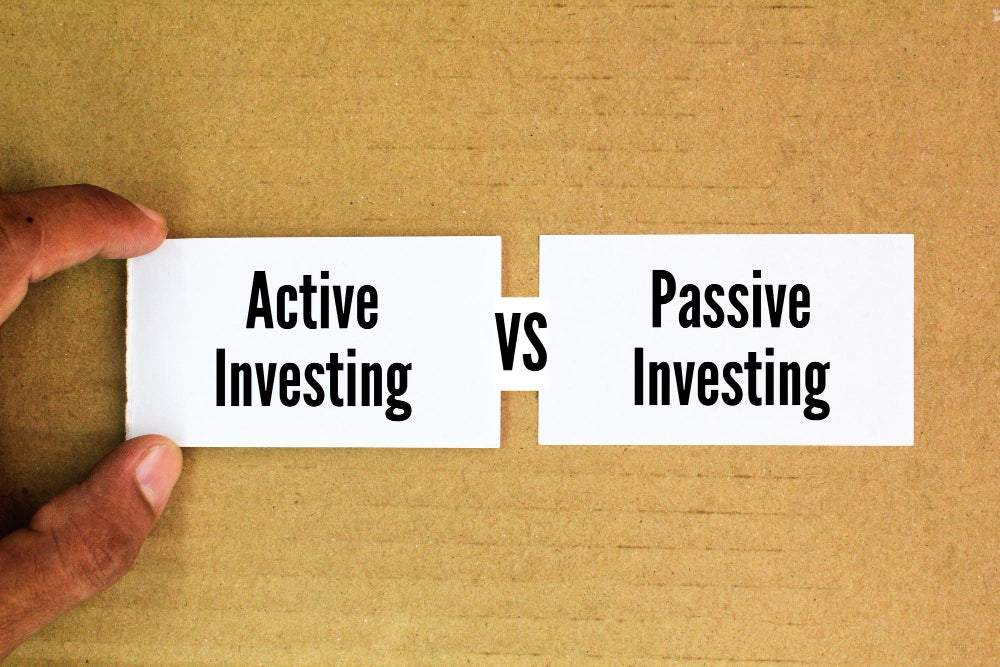
Active vs. Passive Investing: The Pros and Cons You Need to Know
Share
When it comes to investing, one of the most significant decisions you'll face is whether to take an active or passive approach. Both strategies offer unique benefits and come with their challenges, and the right choice often depends on your financial goals, risk tolerance, and personal preferences.
But what exactly are active and passive investing? How do they differ, and which one is better for your financial future? This guide breaks down the advantages and disadvantages of each to help you make an informed decision.
What Is Active and Passive Investing?
Let's define these two approaches before we jump into the pros and cons.
Active Investing
Active investing involves managing your investment portfolio with the goal of outperforming the market. This strategy typically includes frequent buying and selling of stocks, bonds, or other assets based on market trends, research, and financial expertise. Active investors usually rely on portfolio managers or self-directed research to make their decisions.
Key Characteristics of Active Investing:
- Frequent trades and market adjustments.
- Focuses on short-term gains or long-term outperformance.
- Requires in-depth analysis and financial expertise.
- Often associated with hedge funds and mutual funds.
Passive Investing
On the other hand, passive investing aims to mimic the overall market's performance. The goal is to match—not beat—the returns of a specific index, such as the S&P 500. This strategy often involves buying and holding index funds or exchange-traded funds (ETFs) for the long term.
Key Characteristics of Passive Investing:
- Fewer trades and a buy-and-hold approach.
- Focus on long-term growth with minimal market intervention.
- Lower costs and fees due to minimal management.
- Designed to track market benchmarks.
Now that you understand active and passive investing better, let's explore their advantages and disadvantages.
The Pros and Cons of Active Investing
Pros of Active Investing
1. Potential for Higher Returns
One of the biggest draws of active investing is its potential to outperform the market. Skilled portfolio managers can identify and capitalize on market inefficiencies, earning above-average returns. For example, successful active investors may find undervalued stocks or emerging-market opportunities that passive investors might miss.
2. Flexibility in Strategies
Active investors have the flexibility to adapt quickly to market changes. They can buy and sell assets based on current trends, economic news, or company-specific events. This agility can be particularly valuable during periods of market volatility.
3. Tailored Investments
Active investing allows for more customization. You can align your portfolio with personal values, risk tolerance, or financial goals. For instance, an active investor might focus on environmentally friendly companies or high-dividend stocks to meet specific objectives.
4. Short-Term Opportunities
If you enjoy the thrill of short-term gains, active investing offers plenty of opportunities to profit from market fluctuations. Day trading, for example, is an extreme form of active investing that aims to capitalize on daily price swings.
Cons of Active Investing
1. Higher Costs and Fees
Active investing often involves higher expenses, including management fees, research, and transaction charges. Actively managed funds usually charge 1% or higher fees, which can eat into your returns over time.
2. Risk of Underperformance
While active investing offers the chance for higher returns, it also carries a significant risk of underperforming the market. Many actively managed funds fail to beat their benchmarks, particularly after accounting for fees and expenses.
3. Time-Consuming
Active investing requires significant time and effort. Whether managing the portfolio yourself or working with a financial advisor, it involves constant research, analysis, and monitoring of market conditions.
4. Emotional Decision-Making
Active investors are often more prone to making emotional decisions, such as panic selling during market downturns. These reactive choices can lead to costly mistakes.
The Pros and Cons of Passive Investing
Pros of Passive Investing
1. Low Costs
One of the most significant advantages of passive investing is its affordability. Index funds and ETFs typically have 0.1% or lower expense ratios, making them an excellent choice for cost-conscious investors.
2. Long-Term Growth
Passive investing is built for the long term. By riding the overall upward trend of the market, investors can achieve steady growth over time without the need for frequent adjustments.
3. Simplicity
Passive investing is straightforward to implement. You don’t need to analyze market trends or monitor your portfolio constantly. Instead, you can “set it and forget it,” which is perfect for beginners or those with limited time.
4. Lower Risk of Emotional Decisions
Since passive investing involves minimal trading, it reduces the likelihood of making impulsive decisions during market volatility. This disciplined approach can lead to better long-term results.
Cons of Passive Investing
1. Limited Upside Potential
While passive investing offers consistent returns, it needs more potential to outperform the market. There may be better fits than this strategy if you want to achieve above-average gains.
2. Lack of Flexibility
Passive investors have little control over their portfolios. They rely on the performance of the chosen index, which may not align with their specific goals or values.
3. Vulnerability to Market Downturns
Passive investing doesn’t protect against market downturns. Since it mirrors the performance of an index, investors are exposed to the full impact of market declines.
Combining Active and Passive Investing
If you’re still unsure which approach to take, why not consider a hybrid strategy? Combining active and passive investing allows you to enjoy the benefits of both methods. For example:
- Use passive funds for core holdings, such as S&P 500 ETFs, to ensure steady growth.
- Set aside a portion of your portfolio for active investments, focusing on sectors or companies you’re passionate about.
A hybrid approach allows you to achieve short-term gains while maintaining long-term stability.
Which Strategy Is Right for You?
Deciding between active and passive investing depends on several factors:
- Your Financial Goals: Are you looking for steady growth, or do you want to achieve higher returns by taking more risks?
- Time and Expertise: Do you have the time and knowledge to manage an active portfolio, or would a hands-off approach suit you better?
- Costs: Are you comfortable paying higher fees for active management, or do you prefer the cost-efficiency of passive funds?
By evaluating your unique circumstances, you can choose the strategy—or combination of techniques—that best meets your needs.
Take the Next Step Toward Financial Growth
Building wealth through investing doesn’t have to be complicated. Whether you’re drawn to the hands-on excitement of active investing or the simplicity of a passive approach, the key is to get started.
Want to learn more about crafting a successful investment strategy? Check out our interactive financial courses. With engaging animations, relatable scenarios, and expert insights, our program equips you with the skills to make confident financial decisions.
